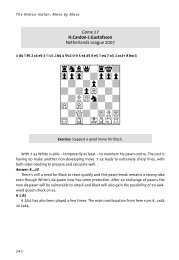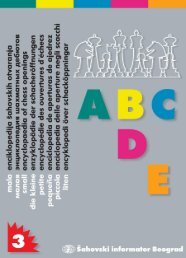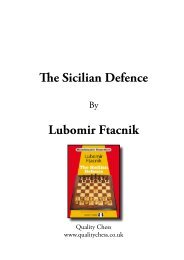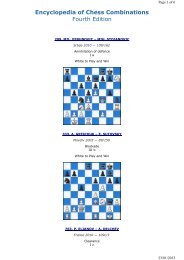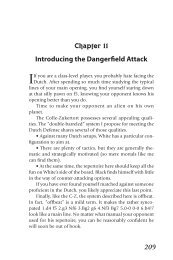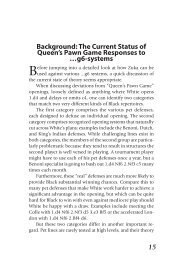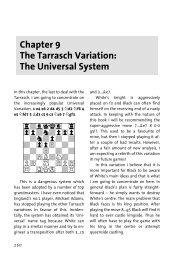You also want an ePaper? Increase the reach of your titles
YUMPU automatically turns print PDFs into web optimized ePapers that Google loves.
18 50 WAYS TO WIN AT CHESSretreat to d7, if attacked by a later g4-g5 thrust.However, the drawback to Black’s plan is thathis development takes longer to complete, andAdams later suggested that he should perhapssettle for 14...Íd7 and 15...Îac8, completinghis mobilization.15 Îad1 (D)B-tl+rvk++pw-+pzpp+-zps-+s-+-+-+-P+-SPZ-++PS-VL+--+PW-+PZ+-+R+R+K15...Ìc6The consistent move here is 15...b6, but thisallows White to break in the centre in energeticstyle by 16 e5!. A typical variation, givenby Adams, would be 16...dxe5 17 fxe5 Ìd7(17...Ëxe5? 18 Íf4 costs Black the exchange)18 Íh5 Ìxe5 (or 18...g6 19 Ëf2) 19 Íf4 g6 20Ìe4, with dangerous threats for the pawn. Notehow in this variation, White is able to bringpressure to bear down the f-file, against the f7-square, thereby illustrating the point made inthe note to 11...Îe8.In view of these lines, Topalov felt that15...b6 was too risky, but in this case, his plan of14...Îb8 must be considered to have been inaccurate,since its whole point was to allow 15...b6and 16...Íb7. This is a good example of how apparentlysmall tactical points can influence strategy.In principle, placing Black’s bishop on b7 isstrategically a good idea, but since it proves tacticallyimpossible to carry out, the whole planbeginning 14...Îb8 is called into question.16 Íf2Adams pointed out that 16 Ëf2! would havebeen stronger here, once again utilizing Black’sweaknesses on the f-file. The threat of 17 e5would then have been awkward to meet. However,the move chosen is also quite good. Whiteintends to bring his bishop to h4, after whichthe threat of e5 gains in strength. Black’s nextmove is designed to prevent this.16...Ìd7 17 Íg3 Ìxd4 18 Ëxd4 b5 19axb5 axb5 20 b4This move is unusual in such positions, sinceit creates weaknesses down the c-file. However,in this particular position, it is more importantto secure the position of White’s knight on c3.White is ready to break with e5, after which thec-file weaknesses will become secondary.20...g6?!This turns out to be just about the decisivemistake. Black was already in trouble, and inAdams’s view, he had no choice but to go intoan inferior ending with 20...Ëc4. White retainsthe better chances after 21 Ëxc4 bxc4 22 b5,but his advantage is significantly less than inthe game.21 e5 d5 (D)W-tl+rvk++-wn+p+p-+-+p+p++p+pZ-+--Z-W-Z-++-S-+LV--+P+-+PZ+-+R+R+K22 f5!Setting in motion what proves to be a winningattack. Black has little choice but to capture,since it is already too late for 22...Ëc4,which loses to 23 fxe6 fxe6 24 Ìxd5! Ëxd4(24...exd5? 25 Íxd5+ costs Black his queen) 25Îxd4 exd5 26 Íxd5+ Êh8 27 Íf7 Îe7 28 e6.22...gxf5 23 Ìxd5! Ëc4Capturing by 23...exd5? loses at once to 24e6; e.g., 24...Ëb6 25 exf7+ Êxf7 26 Íh5+,with a winning attack.24 Ëd2In the middle of an attack, it is natural to keepthe queens on the board, but the computer pointsout that 24 Ìf6+ is also very strong. After24...Ìxf6 25 exf6, the b8-rook is very short ofsquares, and after the further moves 25...Ëxd426 Îxd4 Îb6 27 Îe1, Black is terribly tied up.Nonetheless, Adams’s move is more thematicand pursues the attack on the black king. Themain point is that 24...exd5 loses to 25 Ëg5+



